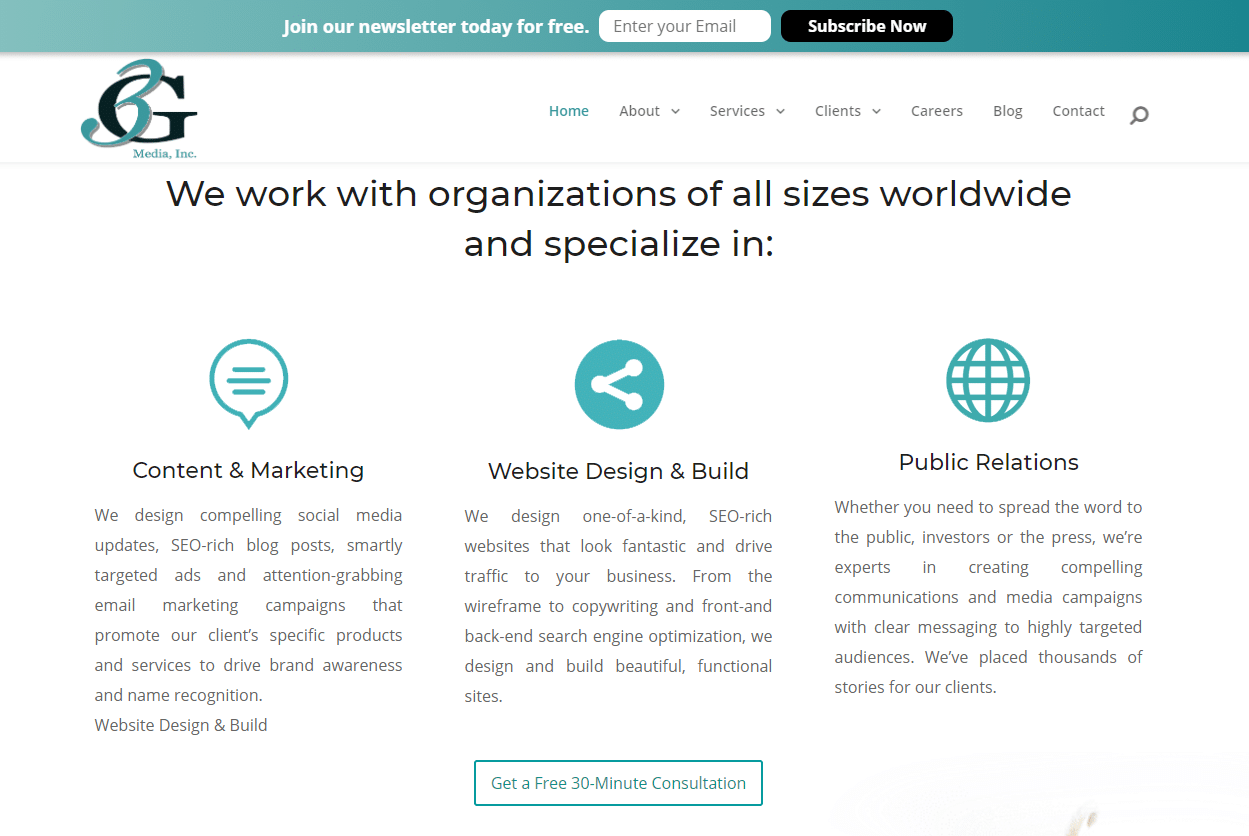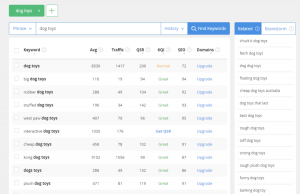Search engine optimization (SEO) is used to improve a website’s ranking on major search engines like Google and Bing. Invesp explains that it is especially useful for businesses to grow and increase revenue, as “more than half (62%) of U.S. consumers with internet access now shop online at least once a month.” Digital marketing is the new norm, and chances are, your business already has a website up and running. In this article, we dig deep into some of the key components of optimizing your website for SEO to take your business to the next level.
Publish Compelling Content Featuring Keywords
Your content is the most important factor in optimizing your website for SEO. There simply is no exception to having quality content. Quality content will attract user traffic, which lends your site authority, ranking you higher in accordance with your SEO. Create content aimed at your business’s target audience, which will help bring in a focused group relevant to your business.
Keywords help users and search engines find you.
A very important component to keep in mind when creating compelling content is keywords. Keywords are essential to optimizing your website for SEO because they are what search engines are looking for when identifying relevant content. With research, you can identify a keyword or keyword phrase for each piece of content you create. Start by thinking about how a user might search to find you on Google. Keyword research tools, like WordStream, can tell you what keywords are most used. Ideally, you want to use keywords that have a high search volume and low competition. Try to use a keyword at least once in every 100 words in your body content and in every title or heading. This will trigger Google’s algorithms to rank your site higher for that keyword.
There are two types of keywords you can use: short-tail keywords and long-tail keywords. Both will help your SEO. Short-tail keywords are usually just one word (e.g., “restaurants”) and usually have the most competition. A long-tail keyword includes several words or a phrase, such as “seafood restaurants in Seattle.” These keywords are likely to have a lower search volume but also less competition. Combining related short-tail and long-tail keywords in your content will maximize your SEO.
Use SEO-Friendly URLs
The definition of a uniform resource locator (URL), according to TheMiesle, is “the location of a specific website, page, or file on the Internet. Every URL is made up of multiple parts, and the way yours is built will have a variety of effects on your site’s security and SEO.” You want to have a semantic URL for SEO purposes. A semantic URL looks something like this: www.threegirlsmedia.com/contact/, as opposed to a messy URL that has a jumble of numbers and letters that are hard to find, such as www.example.com/?p=897643. Try to include your target keywords in your URL; this will make it easier for users to find your site.
Hyperlinks for SEO
From the early years of search engines, hyperlinks to a designated site have counted as votes for popularity. Sites that hav the most links pointing to them are considered to be the most popular, according to Google’s algorithms. By adding hyperlinks to your site, you connect yourself to other relevant sources. Hyperlinks stand as one of the strongest factors in SEO because they are difficult to manipulate.
There are three types of hyperinks: internal, outbound and inbound. Internal links are hyperlinks within your website to another page on your website. These redirect users to a designated page and should increase your click-through rate (CTR), raising your site’s popularity. Outbound links are links to a different website from your own. By linking to high-authority sites, you increase your website’s authority as well. It’s a good idea to include both types of hyperlinks in your content. Inbound links are links from an external website to your site. These are the best types of links in optimizing your website for SEO; however, you have no control over those other sites. That said, you can post your website on your social media channels and encourage users to share your post on their channels or personal websites. This will drive more user traffic and raise your SEO ranking.
Exceptional User Experience
Let’s look at one particular SEO component that can be tricky and quite complex: user experience (UX) design. UX design is important to SEO, as it affects how users interact with your business. Good UX design is essential, so that visitors can navigate your site quickly and easily to reach the end goal: increased business.
For SEO, Google algorithms have ways of measuring the UX performance of a website, mainly by tracking bounce rates, visitor traffic and site security. You do not need to be an expert on UX design; understanding the basics, however, helps you understand how to optimize your website so that it ranks high with Google’s algorithms. Building exceptional UX design aids your SEO in a multitude of ways.
Optimize Your Page Speed
Your website’s page speed is the time it takes for a page to load. Users want their content to appear in as little time as possible. If your website takes too long to load, you will have a high bounce rate and fewer visitors, which can hurt your SEO drastically. In fact, according to Section.io, “32 percent of visitors bounce when page speed is seven seconds[, and] 9.6 percent of visitors bounce when page speed is two seconds”. To maintain a high number of visitors, your page speed needs to take less than two seconds to load.
How do you get your website to load quickly? First, use a free website speed test like Pingdom.com. Look at your page size; ideally, you want it to be between 1 and 3 MB. Anything larger than this means you have some optimization work to do. There are a couple things you can do:
- Compress images. Images can take up the most data on a website. Compress your images using a free image compression program to smaller than 2 MB. An easy way to do this is to change the display resolution to 72 DPI. Programs you can use to compress images include Adobe Photoshop and Fotor; if you use a Mac, the Tools tab has an option to Adjust Size. Another option is to simply search “free image compressor,” and a bunch of free online programs will appear.
Once you’ve compressed all your images, check your website speed again. Your page size will have decreased a bit now.
- Delete unnecessary plugins. This is only applicable to WordPress websites. If you build your website on WordPress, you know how to use plugins. Plugins serve many purposes in building a great website, but they also take up data space and slow your website down. Go through your plugins and delete any you are not using. This will free up some space and help your website perform faster.
Secure Your Website With SSL
As Reliablesoft.com explains, Secure Socket Layer (SSL) is a “security protocol that enforces encrypted communication between the web browser and the web server.”
In 2014, Google decided that all websites needed SSL and now prioritizes these secure websites. Securing your website is important to optimizing your website for SEO. You can tell a website is secure by the URL or from the display of a green padlock at the top of your browser. A website that has SSL can be accessed by using https:// at the beginning of a URL. A website that does not have SSL can be accessed using the simple http://. You can view the full Reliablesoft.com article on how to migrate a website to https without losing SEO, although you may need to call in an expert web developer unless you use WordPress, where the process is a little simpler. Dave Foy created a useful tutorial video for non-coders on how to switch a WordPress site to https, which you can view below.
Use White Space
White space is essential for conveying clarity to your users. It makes your content more legible and allows to focus user attention on what you want them to see first. According to Crazyegg.com, the “use of white space between paragraphs and in the left and right margins increases comprehension by almost 20%. (Lin, 2004).” If you surround text and images you want to emphasize with enough white space, your users will pay attention to these components and your website will be easier to navigate, increasing user traffic and, in conjunction, your SEO ranking.
 Here is an example of a good use of white space.
Here is an example of a good use of white space.
Make Your Website Social Media Friendly
These days, users love social media. Let your website help visitors connect with you and share your site on social media by adding social media links and posting headlines that encourage users to share your profile. Make sure your social media links and contact information are easily visible, and have staff ready to answer any user questions quickly.

Add social media links to your website to increase engagement.
Another thing you should do is share “social proof” to convey credibility and encourage visitors to spread the word about your business. Influential social proof includes testimonials, badges and awards, influencer endorsements, media logos of affiliated businesses, subscriber counts and social connections. These all prove to users that yours is a credible, engaging business and will help increase organic visitors, improving your SEO ranking.
Make Your Site Mobile Friendly
More than 73 percent of the world uses a smartphone or mobile device.
In today’s era, more than 73 percent of the world uses a smartphone or mobile device, according to Oberlo. Of that 73 percent, two-thirds use their mobile devices for online shopping. It is therefore paramount that your website is optimized for mobile usage. Websites optimized for mobile devices consistently have stronger SEO.
Meta Descriptions, Excerpts and Alt Attributes
More back-end SEO tactics include filling out meta descriptions, excerpts and alt attributes correctly, including keywords you’ve researched.
A meta description is defined by Moz as “an HTML attribute that provides a brief summary of a web page. Search engines such as Google often display the meta description in search results, which can influence click-through rates.”
If you use WordPress, add a meta description at the bottom of the page using the Yoast SEO plugin. Google allows a meta description as long as 158 characters, including spaces. Try to get as close to this limit as possible.
The excerpt is similar to the meta description. It’s a snippet of your content that will be displayed on archive pages. If you’re writing an excerpt for a blog post, this will also be displayed on your front page. The excerpt can be as long as 55, so try to get as close to the limit as possible and include keywords or key phrases.
Alt attributes are used to describe image content when the image cannot be rendered. They are also used by screen readers for the sight-impaired. It is important to accurately fill out your alt attributes. Fill out the title and text attributes with an accurate description of the image and, again, include keywords.
Digital & Social Articles on Business 2 Community
(78)
Report Post






